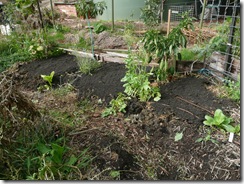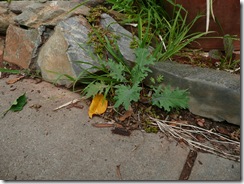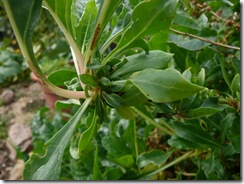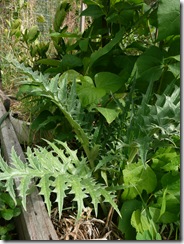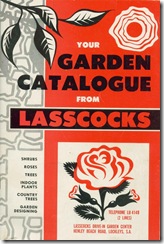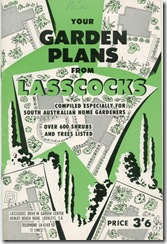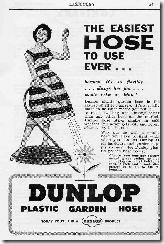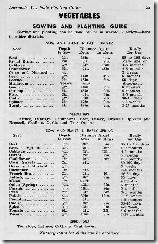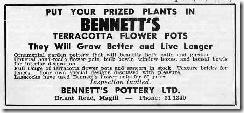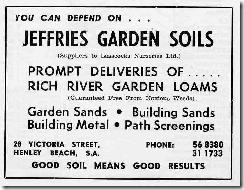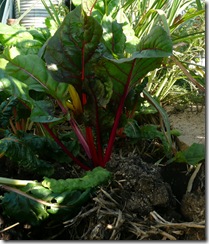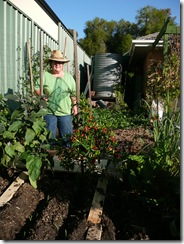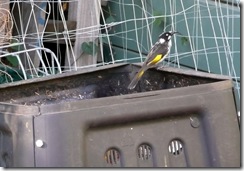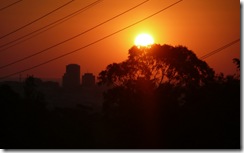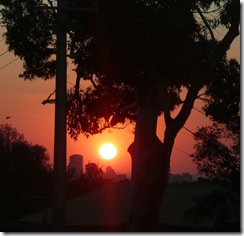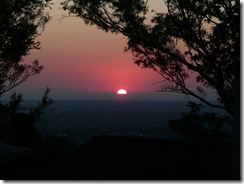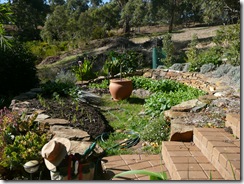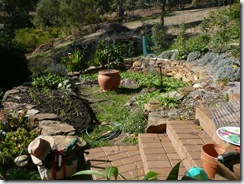Wednesday, 30 April 2008
Hills Vegetables Direct from Farm
So if you want some fresh hills veggies check it out. If you go past the Piccadilly CFS towards Summertown you’ll come to a sweeping bend, on the left there are some big sheds this is the place, there are vines on the right. If you get to the turn off to Piccadilly Nursery you’ve gone too far.
To al those observant recyclers out there I'm on the lookout for peices of broken concrete to make a path with. If you know of or see some let me know.
THE SMALL SOLUTION FOR THE THIRD WORLD FOOD CRISIS
When I got up this morning I decided I wasn't going to write anything today. Nothing. NOT A WORD. Mostly to give my eyes a rest. I have always had great eyesight but...shut-up Kate. OK. I have only been sitting here for 5 minutes, reading, and that is enough to start me off again. I wrote some notes while at the shack, from a great series of articles I read in the October 2001 edition of 'Slow' - the magazine of the Slow Food movement. If you can, I would highly recommend reading it. I guess it is more of the same but it is about food security for the developing world, this time, and includes some excellent research with some facts and figures to mull over. Why, when it was published in 2001, nothing has been done by now in 2008 (as far as I know but that's not a fact) is testament to the western world's addiction to making money at any cost.
If we think food is getting expensive and things are disrupting our normally manageable lives, just take a few minutes to think about people in the third world who, on the one hand, have often had culturally rich and happy lives but, on the other, are now losing their self-reliance as big agri-business seeps like a cancer through their innocent lives. The majority of the several billion people on this planet are not part of an affluent society and do place food security at the top of the list of importance for their families. They have always - and that means for thousands of years, thousands of generations even, saved their seeds and grown their food in their home gardens. This is what a family must do - just a part of their lives - in addition to working their fields or having another job to have something to trade for money or other goods and services. Primarily it has been the women who have taken the responsibility for this seemingly simple and yet vital activity. From a small piece of land they are able to intensively harvest nutritious meals day after day from a diverse range of plants and a few chickens or other small animals. We all know how little space you need and how much you can grow.
In some parts of Africa more than 100 food crops are regularly grown among the cash crops, as food for the small-scale farmers. A study in Nigeria found that home gardens occupying only 2% of a household's farmland accounted for half the farm's total output of food. In Java, villagers cultivate at least 600 recorded species in their home gardens. Such massive gene diversity ensures food security during drought, storms and changing weather patterns as well as rising oil prices and so-called Free-Trade agreements. Nutrition supplied by the variety in these diets is responsible for maintaining a reasonable level of health, free from some of the insidious western diseases such as heart disease, diabetes and cancers.
In a mono-culture there is no such diversity nor is there the intensity. However, agri-business can rightly claim that an area planted with, for example, rice will reap a certain yield per acre. Since no official figures have been collated concerning the small vegetable gardens dotted about in a village nor any notes taken on the nutrition provided or the biodiversity present, these plots are rendered invisible and are not considered as part of the GDP, on paper. And of paper there is plenty when a large company proposes to install a huge mono-culture, over all this land. The villagers are attracted by these foreigners who are promising increased incomes and standards of living for the poor farmers and, in most cases, they readily accept the deals with the blessing of governments who see the growth in commercial agriculture as improving their GDP.
This makes me cry with shame - how can we westerners allow this to happen? We are quite pathetic - you, me, all of us. We can see it won't work but we do nothing to stop it. These lovely people lose their food security overnight. They become tied to a system of agriculture that requires huge inputs of chemicals and oil to sustain it and they become slaves to the company and to anyone who will lend them the money to buy the chemicals and fertilisers and the seed to grow a crop specified by the agri-business. Their food crops disappear, often becoming lost forever. The huge bio-diversity previously supported by their gardens - of plants,birds, insects, even fish and reptiles, are literally chewed up and annihilated causing large infestations of pests which now can reach plague proportions because of the lack of species able to keep them in check. The people, in one generation, often become destitute and aid workers step in to try to at least feed people whose crops fail in a drought or flood or because they can't afford the chemicals. A once proud and happy village becomes a tangle of infighting, disease and depression which can lead to suicides and total collapse. I prefer to call it pre-meditated murder.
It may seem a long shot to draw comparisons between third world experiences and ourselves in Australia but this failure to notice the small, in favour of the huge, is a cross-cultural problem. Let's take a person who grows half of their family's fruit and vegetables.This has an extensive list of benefits to the family's health and that of the planet. It keeps the gardener fit, provides the best possible nutrition for the family, maintains and improves soil health, decreases the family's carbon footprint, is water efficient compared to broad-acre production, recycles all nutrients back into the soil, reduces landfill by removing green waste from rubbish, reduces CO2 emissions as a consequence of reduces food miles, teaches children about many things not the least of which is where their food comes from, lets them connect with the earth and so on.
However, none of this seems worthy of mention or consideration when policies are made regarding how a country should tackle obesity, greenhouse gas emissions, water shortages, mental health, feeding the world, bio-diversity or any other of today's problems within our country and in other parts of the world. Recently I read that it takes about 5,000 litres per day per person for food grown by conventional agricultural methods! If I had that much water I could grow food for, let me see...that's about 1,600,000 litres per year....at least then 10 people probably double that plus have enough for the rest of my garden and for indoor use. Big business steps in with huge plans - build pipelines, import more doctors, more engineers, more tradespeople, make farms bigger, introduce genetically modified crops, store our carbon emissions underground, grow crops to use for fuel. In short, destroy more to solve less.
The absurdity is so obvious and has its roots in the false premise that big is better. However, big problems occur where only big solutions are sought, it seems to me. Most of the above problems are enormous because no-one thought to look at what individuals could contribute, each in their own, small way. Disregarding the small is fatal. Each bee, ant, fish, bird human must be allowed and encouraged to participate if the whole is to survive. If each individual takes some responsibility then the sum of the total will be greater than that of the parts allowing harmony to have a chance to be established, as in the case of the example of the third world gardens. Basically, we can play as an orchestra or as a machine. As members of an orchestra, each gives of themselves for the benefit of the whole group as well as for the listeners, composers, instrument manufacturers, venue operators, ticket sales offices and so on. Small, united groups; big effect, and in charge of their own destiny. If we act as individual cogs of a huge machine, on the other hand, we are powerless to do other than follow the leader with the result being we take no responsibility for the workings or direction of the machine and simply use it as a means to climb the corporate ladder for personal gain.
If all people who grow their own food could stand tall, shoulder to shoulder, we would stretch around the whole circumference of the globe and could become a group prepared to orchestrate change not just for ourselves but for the whole of humanity and life on earth because we would be playing in harmony with each other and at peace with the world. Somehow we have to not just sit here and write stuff, we have to get out and sing together!

A little bit of Action in my life,
A little box of Seedlings by my side.
A little bit of Help is all I need,
A little bit of Hope is what I see.
A little bit of Dancing in the sun,
A little bit of Thinking all night long.
A little bit of Email, here I am,
A little bit of This makes it sound grand!
Mambo number five.

One of my lovely tuberous begonias to brighten a rainy day and a bowl of red capsicum soup to warm the cockles of our hearts.
Tuesday, 29 April 2008
TODAY IN THE GARDEN
My vegetable garden is a strange, crazy, exciting and chaotic place.They say a garden reflects its owner - far be it for me to argue. Looking into every square foot of it there is something erupting into life or bursting into flower or growing magnificent leaves. There are bees, bugs, worms, slaters, birds and me! There is compost, soil, old mulch, dead leaves, rocks. As I finished preparing a bed and finally getting some seeds sown direct, after removing a few of my faithful old friends, the capsicums, one of my favourite songs came on the radio - you know the one - Mambo Number 5. I have changed a few of the word just a bit to reflect what I was sowing and doing - now sing along -
A little bit of Compost in my life,
A little bit of Kale by my side.
A little bit of Chervil's all I need,
A little bit of Parsley's all I see.
A little bit of Mizuna in the sun,
A little bit of Bok Choy all night long.
A little bit of Lettuce here I am,
A little bit of you makes me your fan !
Mambo number five.
This was still on my mind when I came inside to get a cup of coffee and I skipped and danced down the steps, round the corner, all the way to the coffee pot, in time with the music. Now this takes a special skill, honed after years of living in a split-level house where there are 3 or 4 steps up or down between most rooms. To end up in the right room on the right note is not easy! Something I bet you didn't know before!
LIVING SIMPLY AND FEELING SECURE
It is a natural human condition to want to feel secure and, recently in our history, that has meant getting more money. If we look at how things were way before the industrial revolution only 120 years ago, having enough to eat and a place to live meant having security. That is why seedsaving began nearly 10,000 years ago - growing food was the number one priority for small groups of settlers. All the other things that today we connect with being a civilised society came a long time after food security - manufacturing, services of one kind or another, entertainment, transport etc. Somehow though, these other things have crept up the ladder so far that they have taken the place of food security as the number one important thing in our western lives.
Now people are, once again, beginning to think about their food because, for many years, we have not been paying the true cost for relinquishing our food security to big business which has been plundering the earth's resources to compete for your dollar. I am no different to anyone and have spent time and money in the past on buying things without even thinking about the impact I was having on myself, the earth and resources. Somehow though Roger and I have always preferred experiences to money and we began to veer towards harmony with the world, instead of competition with it and other people, soon after getting married a million years ago. This doesn't mean we are hippies or act or dress differently to anyone else. And this is my biggest bone of contention in this whole affair - why do people who are financially comfortable have to plunder the earth in their sad and sorry lives while people with less, often choose to be happy, responsible earthlings?
At the bottom of the hill from where I live is a very expensive area of Adelaide. And yet the blocks are all being divided up and bigger and bigger homes are being built on smaller and smaller peices of land. If you have a million dollars or more to spend on a house why on earth wouldn't you buy as big a piece of land as you could rather than a big house with no land?? Why wouldn't you have a garden and a gardener, big lawns for your children to play on, space to have a BBQ under a tree and little nooks and crannies to sit and enjoy the birds? Why wouldn't you get the gardener to make you a vegetable garden, if you won't make time to do it yourself, where your children can get their hands in the soil, climb fruit trees, make cubby houses, have chickens? It is beyond me to understand this. Everyone complains about their children playing computer games but holy valotta! children need space to explore and run and play. That's why we bought a house on a cheap hill with lots of space and told our boys that if they wanted to play computer games they could go to a friend's house but we weren't having them here. I still don't understand why the top of the hill is cheap and spacious and the bottom is crowded and expensive!
As the western world creeps inevitably closer to losing the plot, people begin to rebel. Good, that means they are at least thinking, if only about themselves. The rising price of food is beginning to become the topic of the radio stations here, now that the weather has cooled and we have had a bit of rain. People look at what my family eats - the photos are everywhere and friends visit this blog even if they don't often comment - and I always take them something from the garden, and they look (askance!) at me, happy, relaxed, enthusiastic, energised and time-rich and they are, perhaps, beginning to see that we are the secure ones. No matter what happened, we could grow nearly everything. With a cow we could have dairy food. We could have meat hens as well as layers and catch the odd rabbit, do a bit of fishing. We don't need much meat. Roger can make and fix anything. To be able to put aside money for old age is a bonus. What will we leave our children? Attitude! The ability to be comfortable knowing how to fend for themselves. A feeling of being a part of the natural world, not just the man-made world. Enthusiasm and self-confidence. If they are lucky they will get the shack. What more could they want? Going without makes you grow within.
It is a good feeling to be self-reliant and to me that is what real life is all about. Security is only as far away as your garden.
"Only when the last tree has died and the last river been poisoned and the last fish been caught will we realise we cannot eat money." Cree saying.
Monday, 28 April 2008
CARDOONS


 Today has been an interesting introduction to the cardoon, for Deb and I. A while ago we found a whole article about them on A Postcard from Paris. Deb has been growing one since spring and, after tying up the stems for a few weeks, to blanch them, she decided it was time to harvest it. It was a massive thing which Deb single-handedly wrestled to the ground, while I took the photos. It looked vicious but the spiky bits were not actually sharp or prickly but I was glad her hefty knife was between me and it! The stems are thick and celery-like so we tried a little bit raw from the very heart and it seemed quite nice...for a minute...and then it became incredibly bitter. Oh well, raw artichokes taste the same so with a bit of cooking it should be OK, we decided.
Today has been an interesting introduction to the cardoon, for Deb and I. A while ago we found a whole article about them on A Postcard from Paris. Deb has been growing one since spring and, after tying up the stems for a few weeks, to blanch them, she decided it was time to harvest it. It was a massive thing which Deb single-handedly wrestled to the ground, while I took the photos. It looked vicious but the spiky bits were not actually sharp or prickly but I was glad her hefty knife was between me and it! The stems are thick and celery-like so we tried a little bit raw from the very heart and it seemed quite nice...for a minute...and then it became incredibly bitter. Oh well, raw artichokes taste the same so with a bit of cooking it should be OK, we decided.


Sunday, 27 April 2008
LINKS TO PERSONAL BLOGS
There are things I want to write about which I cannot remotely link to this blog's theme of growing heirloom vegetables and what this means to us and the world. Consequently these thoughts are never written and keep niggling at me, like a tiny, deep splinter, invisible but their presence intensified when disturbed. I have to find some way to get the splinters out so I am going to make a link from this blog to a page which will contain a list of the personal blogs of members of the Hills and Plains Seedsavers. I know one or two who already have personal blogs and others who would like to in the future. Readers will be able to follow the lives and thoughts of these people if they wish and, more exciting, the blog owners will have total freedom to be as diverse and self-indulgent as they choose. I, for one, can't wait!! I am not good at remaining within boundaries for long before I begin to push up against the fence, looking for a way to break free.
Well....here is my first post. In the future, look under the Australian links "Adelaide - blogs of members".
Rain, rain, rain.
At the beginning of the month we received 35.5 mm of rain, it quickly soaked into the thirsty soil, everything turned greenand the fungus burst forth.
So far in April we have had 87.8 mm, more than most , but there is a long way to go for a full recovery and 'normal' rainfall pattern as the ponds are still mostly dry.
See what's happening at Nirvana Organic Farm and in Deb's vegetable garden.
.
Saturday, 26 April 2008
KANGAROO ISLAND BEEKEEPERS
K.I. BEEKEEPERS ASSOCIATION
No. 71 April, 2008
Dr. Duke reports he has been successful in obtaining funding by a grant from the National Health and Medical Research Council’s Special Call into Complementary and Alternative Medicine (CAM), grant for $285,000 over three years on “Complementary medicines based on propolis produced by honeybees from Australian flora”.
The CAM call was a highly competitive process that resulted in only 9.4% of the applications being funded.
Dr. Duke will now be visiting Kangaroo Island between the 16th – 20th May to collect samples of vegetation so as to identify the source of the unique compounds identified from Kangaroo Island propolis.The members will be asked to indicate whether they wish the Association to host an informal meeting to provide an opportunity to meet Dr. Duke during his visit, or whether some other function should be arranged.
SNIPPETS FROM THE WORLD OF BEEKEEPERS
An excerpt from The Daily Northwestern
Monday, January 28, 1889 Oshkosh, Wisconsin
Pigeons and Bees
A Pigeon fancier of Hamme, Prussia, made a bet that a dozen bees liberated three miles from their hive would reach it in better time than a dozen pigeons would reach their cote from the same distance. The competitors were given wing at Rynhern, a village nearly a league from Hamme, and the first bee finished a quarter of a minute in advance of the first pigeon, three other bees reached the goal before the second pigeon, the main body of both detachments finished almost simultaneously an instant or two later. The bees, too, had been handicapped in the race, having been rolled in flour before starting, for the purposes of identification.
Friday, 25 April 2008
THE SIEVE SOLUTION
Let's look at food. On the outskirts of Adelaide is a fertile area, once river flats and still prone to flooding in extreme weather, which has always been the food bowl of South Australia. We are very lucky to have this only maybe 15 km from the city centre. There, people like Tony Scarfo have always grown nearly all the vegetables we need for our city and state. In recent years, with new free-trade agreements popping up between our government and just about anyone that will sign up with us, we have been inundated with cheap food, especially from China and America because labour in China is cheap and American agriculture is subsidised by the government and ours is not.
The local food-producers have been squeezed to the point where many have left the industry and their land has been sold and subdivided into houses. I feel very tight in the chest when I drive out that way and see all that beautiful soil being covered with concrete. Sacrilegious and so short-sighted; I want to shout from the roof-tops and usually bombard any passengers in my car with my thoughts until we get to greener pastures, so to speak! Tony's organic market garden has few inputs that come from far away - he saves all his own seeds, he buys manure from local farms and makes compost from it and from his own green crops and weeds etc. It is labour that means Tony's vegetables, grown on just 4 acres, have been slightly more expensive than the cheapest non-organic ones. He employs some local men to weed and to plant out seedlings and his mother helps with tending the seed beds. The only oil involved is in his delivering the food to the 3 or so places that sell his vegetables in his ute, twice a week.
As fuel becomes more expensive fuel-miles becomes a considerable cost - this means not just transporting the final product to the destination of sale but, as well, anything made from oil used in its production - artificial fertilisers, manufacture and running of machinery for sowing, harvesting and processing, as well as disposal of wastes, the running of huge refrigerated warehouses, production and distribution of advertising materials and so on down the line. These costs are already filtering down to the consumer and I notice at the central market, that I can buy Tony's beautiful, local, organic broccoli for the same price as oil-rich, non-organic broccoli from interstate. If you currently buy packaged food, which I don't, your expenses are sky-rocketing while mine are not (even if I didn't grow nearly all our own vegetables). Local is becoming cheap again. (sigh...)
This is an unforeseen way to help speed up the uptake of local, energy-efficient food and other products without the public having to actually do anything intelligent! It may just happen to be the most wonderfully simple solution, at least for us here in Adelaide and for that beautiful soil just north of the city. I cannot give any more time to this now and I want to really delve into these ideas in more depth but this is a start and I will get back to it again in the future, looking more widely at the effects of energy consumption on how we live.
Thursday, 24 April 2008
WALTZING MATILDA

As I was driving home from my mother's just now they played a new version of Waltzing Matilda by John Shuman (?), on the radio. It started me thinking about the connections we feel with a group or nationality and a land. That song encapsulates, for me, what it is to be Australian and it must do for nearly all Australians because there wouldn't be an Australian who couldn't sing it, more or less, if push came to shove. And I once sang it when I was 20 - totally out of tune and very badly - to a busload of Japanese, in Japan, who spoke not a word of English! But that's another story. It has never been our national anthem and yet we claim it as our song, with more love and pride than the official anthem and that is what makes Australians, Australian. Generally, we don't give a hoot about what the government or any authority says, we will get up and do things our own way, come hell or high water and do a bloody good job of it as well. Here is the gist of the song, as I see it:
Who'll come a waltzing matilda with me? "
He jumps into the river and maybe he couldn't swim or he got caught up in snags under the water because that's the last they see of him. A bit of a bad idea, as it turned out but I think we would all agree it was worth a try and we kind of secretly admire him for sticking it at authority! At least he didn't get caught! And I really think that he used a reed to breathe through until the troops left and then crawled out and went off somewhere to light a fire and cook his meat and his ghost may be heard laughing its head off at a mighty fine prank! I wonder if any other country holds so dear a song about a bit of crooked bloke wandering around the countryside on the look-out for a bargain?? Who else would have had a Prime Minister in the Guiness Book of Records for skulling the most beer, earlier in his life?

There are several other beautiful tear-jerking Australian songs and none more so than the one they used to use for the Qantas ads - "I Still Call Australia Home". But I want to know - "Advance Australia Fair"(the national anthem) or "Waltzing Matilda"(the larrikin's anthem) - which song do you Australian readers feel more attached to?
FROM GREEN ROOFING TO VERTICAL FARMING
Of course, our Australian Parliament House has had a turf roof since it was built 30 or more years ago and I have always like its creative design. It looks great from above, as you can see here.
I love reading Greg's posts as they are a combination of great information, complete with links to yet more reading, as well as his own views and ideas. All he needs now is a vegetable garden of his own to get the greening going faster!
Wednesday, 23 April 2008
GROW, PREPARE, EAT
 Tonight I made a big bowl green salad using lots of young leaves from the garden, none of which were lettuce. (Asian bits and pieces, rocket, sweet potato leaves, broccoletti leaves, stems and flowers, marigold flowers, nasturtium leaves, lots of new, young sorrel, basil and probably some other things).Sliced up some of the different coloured capsicums, sprinkled on some persimon seeds, a cucumber and some thin slithers of yellow squash. A few drops of peanut oil and a dash of home-made verjuice and serve with pumkin soup - first rogue pumpkin of the season - plus some nice sourdough bread. Shame there's only Roger and me to eat it all.
Tonight I made a big bowl green salad using lots of young leaves from the garden, none of which were lettuce. (Asian bits and pieces, rocket, sweet potato leaves, broccoletti leaves, stems and flowers, marigold flowers, nasturtium leaves, lots of new, young sorrel, basil and probably some other things).Sliced up some of the different coloured capsicums, sprinkled on some persimon seeds, a cucumber and some thin slithers of yellow squash. A few drops of peanut oil and a dash of home-made verjuice and serve with pumkin soup - first rogue pumpkin of the season - plus some nice sourdough bread. Shame there's only Roger and me to eat it all.  Another day I will cook the eggplant and the rest of the squash and a couple of red capsicums.
Another day I will cook the eggplant and the rest of the squash and a couple of red capsicums.


 Done! 8 pm Wednesday, April twenty-something - and it only took, let's see, I sowed the capsicums in about September - that's 7 months ago. It's not fast food, really, but it's darn good food!
Done! 8 pm Wednesday, April twenty-something - and it only took, let's see, I sowed the capsicums in about September - that's 7 months ago. It's not fast food, really, but it's darn good food!SEEDS FOR HEALTH
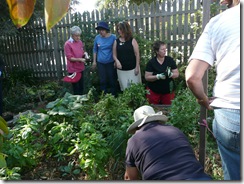 Fulfillment is one of those words I have never had cause to use before but now it is the best word to describe what I have gained today. Giving talks is not my favourite past-time but, along with competition and sometimes popularity (not, luckily, something I attract!) it is a thing that gets in the way of doing what you love, if you love a thing enough. Diana's 'Seeds for Health' course is going along nicely at the Fern Ave Community Garden and since I didn't have my usual morning gardening group today because of the school holidays, I agreed to talk about things related to seedsaving and our group etc. Give me time and I will give you all the talk you want about this subject if you invite me to talk in a food garden setting.They were all lovely people and I saw various looks in the eyes of the listeners- really participators, as it was over a period of a few hours of Diana's practical as well - but one lady in particular was focused and tuned in. At every opportunity throughout the whole session she came and spoke to me, with more and more questions. It all clicked for her and I feel an amazing sense of fulfillment in that. Like Pattie says "One person, one seed, where will it lead?"
Fulfillment is one of those words I have never had cause to use before but now it is the best word to describe what I have gained today. Giving talks is not my favourite past-time but, along with competition and sometimes popularity (not, luckily, something I attract!) it is a thing that gets in the way of doing what you love, if you love a thing enough. Diana's 'Seeds for Health' course is going along nicely at the Fern Ave Community Garden and since I didn't have my usual morning gardening group today because of the school holidays, I agreed to talk about things related to seedsaving and our group etc. Give me time and I will give you all the talk you want about this subject if you invite me to talk in a food garden setting.They were all lovely people and I saw various looks in the eyes of the listeners- really participators, as it was over a period of a few hours of Diana's practical as well - but one lady in particular was focused and tuned in. At every opportunity throughout the whole session she came and spoke to me, with more and more questions. It all clicked for her and I feel an amazing sense of fulfillment in that. Like Pattie says "One person, one seed, where will it lead?"
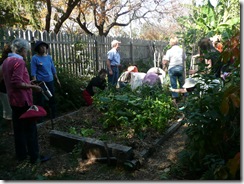 Of course it was wonderful to share some time at the end with a kindred soul like Diana and explore life, the universe and everything. And Cath does a great job of looking after the plot while keeping a constant supply of lunch ingredients growing on for the participants. She and I had a lovely chat at the market last week over a cup of tea and it was good to see her again today.We have a lot more to talk about yet!
Of course it was wonderful to share some time at the end with a kindred soul like Diana and explore life, the universe and everything. And Cath does a great job of looking after the plot while keeping a constant supply of lunch ingredients growing on for the participants. She and I had a lovely chat at the market last week over a cup of tea and it was good to see her again today.We have a lot more to talk about yet!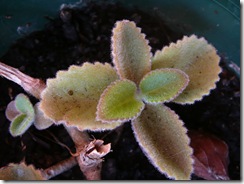
One person brought along this herb which neither Diana nor I had seen before. It smells like oregano and has small, succulent, hairy leaves. Anyone know it?... Yes! Someone sent me an email and here is the information: It is called 'Mother of Herbs' or Coleus amboinicus syn. C. aromaticus, C. abroicus, Plectranthus amboinicus F. Lamiaceae . Very potent sleep-inducer and it has other health properties - see the site Herbs Are Special. Thanks!
In a community garden it is nice to not just be a visitor but to feel a part of the work, which is how it was today. This last week has been full of one-on-one chats with a person a day for me, often in their gardens. The perfect scenario. I hope it continues. All invitations gratefully accepted! Email me anytime!
Tuesday, 22 April 2008
1964 GARDEN GUIDE
I have been looking through some more of my father's old catalogues from Lasscock's Nursery. This time the 1964 edition plus a garden plan guide. It just shows that what comes around goes around, in a lot of ways. There are two pages of "shrubs and trees to withstand severe heat" and several pages on vegetables and fruit trees. Interestingly all the plants in the catalogue are listed by their botanical names(except for fruit and veg), with common names for only some and those are in brackets. No catering to the uneducated in those days! This is a comprehensive 90 page book which was produced annually and posted all over the country because Lasscock's, in 1964, was the largest nursery in The Commonwealth (as Australia was often called back then), and went on to being the largest in the southern hemisphere - something my father was very proud of.
On the left is one of a series of suggested garden plans. I loved looking through them today and seeing what was grown where, when I was 6 years old. Every plan included a vegetable garden and ranged from a few to many fruit trees. As I said before, all the lists are of botanical names and they are familiar enough to me because my father taught me the names of thousands of shrubs and trees from a very young age, although I had no idea what they looked like! It was rather an exercise in spelling, mental athletics and pronunciation, I think!
Here are some of the advertisements in that catalogue. These 3 businesses are still going today in Adelaide, although their addresses have changed.
SUNDAY AFTERNOON IN THE SUBURBS
Another man came out and spoke to the first, lighting up another cigarette. They stood there, smoking and talking. I could smell a BBQ and hear someone playing a guitar. Other people were visible in their yard because they had left the wooden side gate open. Still I waited. I moved the gate around a bit to get a look down the street - the street where I had lived for 24 years and still visit every week. A teenager turned up and went to knock on a door nearby. A young mother walked past with a pusher plus two little boys walking and chatting. She looked at me, still holding the gate and we chatted for a few seconds. I was enjoying the amateur guitatist - it reminded me of son Hugh playing his accoustic guitar and singing.
The light was becoming softer and a shadow from my mother's jacaranda tree crept across where I was standing. The two men finished their cigarettes, turned back towards the group gathered inside the yard and one of the blokes put his arm around the other in a comforting kind of way and I wondered what had passed between them in their moments there, alone, but barely separated from the activity inside.
It was only a few minutes, but there, in my own childhood street, anchored as I was to the spot and forced to observe, I felt good about the world. There is gentleness and kindness where we least expect it. There are families spending the last days of our Indian summer gathered in their homes cooking, laughing and playing with their children. We were there, helping my mother. Life is good. Never forget it.
Monday, 21 April 2008
APRIL AT BARB'S
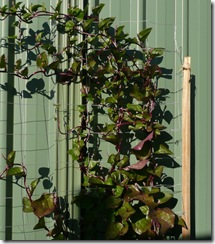
I never cease to be amazed at Barb. There she is, having just completed one full year of gardening, after more years of no t gardening than she would care me to mention here, and there is so much happening in every nook and cranny of her interesting edible garden area. First thing I noticed was this climbing Malabar Spinach, which is just coming into flower.
Next was this thick patch of parsnips. if there is one thing I always have trouble with its getting parsnips to germinate but Barb's seedlings are already well advanced and, by the density of growth, it looks like every seed must have germinated.
When her phone rang I was wandering around alone and came across this eggplant with these deep purple leaves - some were almost black. I forgot to ask her what it is called.
Apart from ordinary things like lettuce, capsicums, chilis etc she has things like yacon, hicoma(?) and snake beans.
The next season's seeds and seedlings are coming up and growing well - various kale, garlic, leeks and some beautiful red beet.
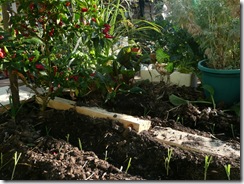
Leaving gardening aside for a moment, I have to declare here and now that I think Barb is a great person and can put up with me for infrequent but seriously long visits and has a wonderful ear and a kind heart!
This little New Holland Honey-eater is a friend of Barb's who loves to dive into the compost bin when Barb leaves the lid off - which she often does especially for him.
Recently Barb has learnt how to make this beautiful olive oil soap, which just happens, as luck would have it, to be my favourite. So Barb insisted I take these home. I never go home empty-handed from these visits.
I stopped 3 times on the way home to watch the sunset - somehow it says a lot about how I felt just then too. I have done nothing more than crop these photos a bit (and badly) - it was a pretty glorious event. Funny how things turn out, isn't it. Take care Barb.
THE COMFORTABLE CHAOS THEORY IS BORN
Spraying a fine lovely shower of water over some tiny plants is a glorious past-time and really sharpens all your senses. First, you feel and hear that first burst of energy as the water arrives at the nozzle-end of the hose and then the cool (or hot, if you've left the hose lying in the sun) tingle on your fingers if, like me, you herald the arrival of the water by letting it pour over your hand on its way to the soil. It is the next best thing to standing under a waterfall. Next the plants and earth release a wonderful sigh of the aroma of life and if you close your eyes, you can absorb it into your own breath. The light always catches in the droplets differently and reflects like little jewels on the leaves of even the tiniest of seedlings, maybe for the very first time. New life gets its first drink. Everything responds to water, including me, and I can forget about why I am watering, for a while, and just enjoy the simple pleasure of connecting with our most basic human need - water.
Too soon the dream gives way to reality and my thoughts don't just wander off but are rudely snatched away by the heat of the day and fall into some terrible hole somewhere, from which it takes some effort to climb out, at times, and at other times it seems like a better idea to stay there and try to work out how to make a terrible, hot hole into a cool, shady cave.Which is what I did today. It was somewhere down there, an hour or two ago, out in the garden that I came across "The comfortable chaos theory". I read a lot of stuff and I try to cut through the chaff to get to the seed and it is interesting to see how many other people are doing the same, in books, on the radio and TV, and here in Etherland (I don't bother with newspapers). Most people's general thoughts range around one seed in particular - oil. The consensus I hear (not, however, my view) is that an energy crisis involving reduced oil supplies will cause a collapse which must, at all costs, be stopped / side-stepped / diverted and that life without astronomical reserves of oil will be reduced to chaos.
Always contrary to popular opinion, I see that what we have now, at this time, is total chaos - but one with which people have, over time, become totally comfortable. Hence "The comfortable chaos theory". Imagine trying to explain to an alien about the ridiculous complexities we think of as normal today, just for example in the world of agriculture. Someone knocks down a huge swathe of virgin forest, killing all animals and plants that could have provided some food or other useful purpose to people, burns it all and then plants into the soil, (now subject to erosion and, in a lot of cases requiring irrigation by pipes full of water from hundreds of kilometres away) the seeds of plants not native to the area, or selected for their benefit to human health and more and more often genetically modified to withstand vast amounts of chemicals to be poured onto them in order to get them to produce a crop that is harvested and made into fuel to drive the machinery needed to tend the next crop! And the fuel is called bio-fuel. And this is normal? This is definitely a serious state of total chaos to which so many people have become inoculated that it has become a comfortable chaos.
In the future - if there is one - crops may be grown from local seed, some of which will be native to the area, and every plant grown will provide nutrition to those who eat it, including the wildlife. Pretty simple idea. This doesn't sound too much like chaos to me. It sounds very sane (that's for you Brett!). People say "yes but...." and I say no. Stop. We are on the wrong path. Your path leads to a big, hot, black, nuclear hole. My path leads to a cool, moist, shady cave.
Which one will you choose?
BLOGGERS GET-TOGETHER UPDATE
This is International Kitchen Gardeners day and our seedsavers group celebrates it with a lunch provided by everyone, made with anything from our gardens. That time of the year there is a lot of beautiful stuff in the vegie patch and preserves in the cupboards. All (and only) veg-garden-bloggers and their families would be welcome to join us, but only via personal contact with me. I hope it will be at Deb's again (see photos for last year's perfect setting).
Depending on cars available, other activities on other days would revolve around some visits to farmers' markets, our Adelaide central market (Friday), friends' gardens, my garden, a trip south to McLaren Vale and Fleurieu peninsula for cheesewrights, wineries, artisan stuff and maybe (if you're up for it) stay overnight in Willunga Friday night (or maybe camp on a nearby dairy I know, depending on the weather) and have dinner at a beaut place called Russells Pizzas (made from local ingredients and cooked in an outdoor pizza oven by Russell who...well..is a nice, earthy, pretty lovely sort of bloke!) Then there is the hills to explore and the Barossa Valley (for those who like more wine than me). Depending on who comes I can do ...well...almost anything to make it a great inaugural experience. Of course the focus would be primarily on growing food, cooking it, talking to each other and seeing what we have around Adelaide that keeps me here when I'd much rather be somewhere cool and wet, in the mountains and surrounded by thunderous rivers and green summer grasses! One day soon...
Tricky to promise anything yet since I haven't discussed the details with anyone, but I know they are with me in principal, so far.
I have put a link to a document called Blog-over for Kitchen Gardeners (you know, like sleep-over... OK maybe I will change the name eventually!).So check it for info and send me comments or emails to tell me what you are thinking. Thanks to the person who voted 'No, you are a nutcase' - I guess I asked for it!
Sunday, 20 April 2008
GREEN MANURISTA
A video debut! Why not reduce the words written and say it with action? Was it worth the embarrassment??See below.
This time of the year - all over the world but mostly in the northern hemisphere - people are digging in green manure. Dumb name, great idea. The idea is to grow some really soil-enhancing crop, nice and thickly, let it get to the almost flowering stage then dig it into the soil. Leave it for... (here opinions vary and Deb may shout me down for my slack methods!) anything from 5 minutes to 5 weeks, depending on how much leaf matter you have and how long before you want to plant something in that space and you wish to heavens you had dug it in ages ago (the latter often being me). Deb has got us all going on this moon-phase thing and it is therefore now (or 2 days ago, actually) time to plant my garlic but I hadn't finally decided where to plant it until this morning!
I had snuck a green manure crop of bio-mustard (what mustard isn't 'bio'??) in after removing my tomatoes in late January due to total annihilation by a pest that is fairly new to Adelaide, at least in these proportions, and that is tiny red mites, invisible to the naked eye. I chose mustard as it is quick to germinate and grow this time of the year and is better than leaving the soil bare. Now it is time to dig it in and quickly get my garlic planted before Deb finds out I am running late!
You may be as shocked as I was to see and hear me in this video! I... well...make up your own mind...
If the soil had been a little damper it would have turned more smoothly. However, I think you get the idea. It is not a good idea to turn the soil over from down too deep, so this method is quite adequate for this purpose.The chopping is a vital step if you are going to have any hope of covering the leaves - just try not chopping it and you will see what I mean.(Another of my experiences I hope to save you from, dear reader.) It saves your back and means you still have the energy left to shovel a couple barrow-loads of compost over the whole thing, along with some blood and bone (to counteract the nitrogen draw-down that may occur when I plant directly into this tomorrow morning) and fork in roughly.Then smooth out with the rake. Watering well is of prime importance - as I have said before - never, ever plant or sow into dry soil and think you will wet it later because you will wash all the seeds and topsoil all over the place and it will still be dry underneath. I speak from experience here too!
Ideally you would leave this to do its thing for a couple of weeks this time of the year here, to get the worms all excited and busy working away on those green leaves under the soil and to multiply those millions of micro-organisms per square foot into trillions so they are ready to supply the garlic crop with everything they will need to get some growth on before the soil cools down (although I am beginning to think that this may be sometime several hundred or thousand of years in the future rather than a couple of months, and that's not funny!). But I don't have time and garlic is pretty robust, so that's the way of it this time. Suddenly I realise that I am sounding very much like my father....and I for one always thought he was very eccentric and a bit crazy - lucky I didn't inherit those genes too!?
Why Green Manurista in the title? Well, I have been practicing my Italian while turning the soil and since lots of things get an 'a' on them for the female version, in Italian, I thought I would turn 'manure' into 'manurist' then into 'manurista' - to describe a female person doing stuff with 'manure'. Well, what about 'barista' ? That is really a female doing stuff in a 'bar' which is like a cafe, in Australia. No, not that kind of stuff! This is a family blog.
Saturday, 19 April 2008
Playing in the pumpkin patch…

One of the best catchments I have on the property is the concrete driveway; this slopes down beside the house and empties onto the back lawn. I figured there would be some thunderstorm activity every few weeks over summer, and that the run-off would water a large pumpkin patch. Pumpkins need plenty of sun and take up lots of room, so I sprayed out the Kikuyu grass with RoundUp, waited a few weeks for the lawn to die, and planted my seed-saver’s Butternut pumpkins along the top and side of this new ground to take advantage of all the free rainfall I figured would supplement my miserable town water ration.
Well, nearly everything went wrong, as it so often does when one attempts something new.
The seeds turned out to be a few Butternuts, but mostly Jap pumpkins, a few zucchinis and even a cucumber or two. I know I muddle up my seeds, but I figured others were better organised than I was.
The thunderstorms never came, except once, and so my water ration wound up on rogue pumpkins, and I had to use tank water on the rest of the veggies.
However, I’d not been idle at my workbench – I’d invented a low-cost gadget to show me the ‘water level’ in the soil, and this was duly planted in the pumpkin patch. This worked fine, and I could even see it from the kitchen window 15m away, not to mention getting an eyeful each time I visited the seedbeds or the rainwater tanks.
As a scorcher of a summer has passed into a dry autumn, the pumpkins have spread alarmingly. One is heading off over the orange tree to kidnap the old lady next door, and another is trying to creep up on the BBQ and make off with it. I did learn that pumpkins are easy to train; when they threaten to wander out across the path or up the clothes-line, one need only drag their long tendrils back 'into the square' and they err no more.
If only it would rain!

